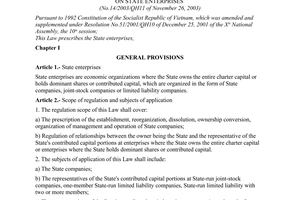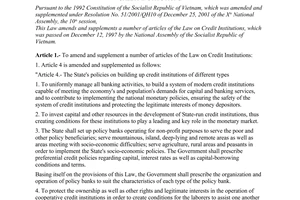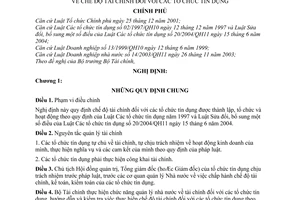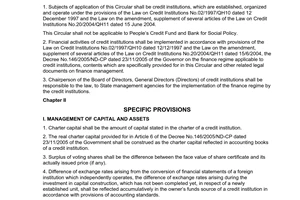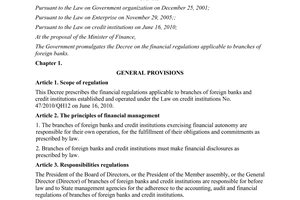Decree No. 146/2005/ND-CP of November 23, 2005, on financial regime applicable to credit institutions. đã được thay thế bởi Decree No. 57/2012/ND-CP on the financial regulations applicable to branches và được áp dụng kể từ ngày 15/09/2012.
Nội dung toàn văn Decree No. 146/2005/ND-CP of November 23, 2005, on financial regime applicable to credit institutions.
|
THE
GOVERNMENT |
SOCIALIST
REPUBLIC OF VIET NAM |
|
No. 146/2005/ND-CP |
Hanoi, November 23, 2005 |
DECREE
ON FINANCIAL REGIME APPLICABLE TO CREDIT INSTITUTIONS
THE GOVERNMENT
Pursuant to the Law on Organization
of the Government dated 25 December 2001;
Pursuant to the Law on Credit Institutions dated 12 December 1997 as amended by
Law No. 20/2004/QH11 dated 15 June 2004;
Pursuant to the Law on Enterprises dated 12 June 1999;
Pursuant to the Law on State Owned Enterprises dated 26 November 2003; On the
proposal of the Minister of Finance;
DECREES:
Chapter I
GENERAL PROVISIONS
Article 1. Governing scope
This Decree regulates the financial regime applicable to credit institutions established, organized and operating pursuant to the Law on Credit Institutions dated 12 December 1997 as amended by Law No. 20/2004/QH11 dated 15 June 2004.
Article 2. Principles on financial management
1. Credit institutions shall be financially autonomous and self-responsible for their own business operations, and shall discharge their obligations and fulfil their commitments in accordance with law.
2. Credit institutions shall make their finances known to the public1.
Article 3. Chairmen of boards of management and general directors (directors) of credit institutions shall be liable before the law and before State administrative bodies for the observance of the financial, accounting and auditing regimes applicable to credit institutions.
Article 4. The Ministry of Finance shall perform the function of State financial administration of credit institutions, and shall guide and inspect credit institutions in implementing the financial regime pursuant to law.
Chapter II
MANAGEMENT AND USE OF CAPITAL AND ASSETS
Article 5. Working capital of credit institutions
[The working capital of a credit institution shall comprise:]
1. Equity:
(a) Charter capital;
(b) Differences arising from revaluation of assets and exchange rate differences prescribed by law;
(c) Shareholding capital surplus;
(d) Reserve fund for supplementation of charter capital, professional development investment fund, and financial reserve fund;
(dd) Retained profit.
2. Mobilized capital:
(a) Capital mobilized from cash deposits of organizations and individuals;
(b) Capital borrowed from domestic and foreign credit institutions;
(c) Borrowings from the State Bank;
(d) Issuance of valuable papers.
3. Other capital as stipulated by law.
Article 6. Credit institutions must, throughout the course of their operation, ensure that their actual charter capital level is not lower than the legal capital level stipulated by the Government for such type of credit institution.
In a case of changing the charter capital, the credit institution must publicize the new amount of its charter capital.
Article 7. Use of capital and assets
1. Credit institutions shall be permitted to use their working capital to conduct business pursuant to the Law on Credit Institutions, ensuring the principle of capital safety and development. Credit institutions may use not more than 50% of their own level one equity (pursuant to guidelines of the State Bank) for investment in construction and procurement of fixed assets, and they must observe all State regulations on management of investment and construction.
2. Credit institutions shall have the right to restructure their capital and assets in order to service development of their business operation.
3. The transfer of capital and assets as between branches or independent member companies of a credit institution shall comply with the regulations of the board of management of such credit institution.
Article 8. Capital contribution and share purchase
1. Credit institutions shall be permitted to use their charter capital and reserve funds in order to contribute capital to [and/or] purchase shares in enterprises and other credit institutions in accordance with law.
2. The board of management of a credit institution shall itself decide or authorize the general director (director) to decide on contribution of capital to [and/or] purchase of shares in enterprises and other credit institutions in accordance with law.
3. Credit institutions shall be permitted to contribute capital to joint ventures using the value of land use rights in accordance with the law on land.
4. A credit institution shall not be permitted to purchase shares in, or to contribute capital to another enterprise where a manager, executive or principal owner of such other enterprise is the spouse, parent, child or sibling of a member of the board of management, board of controllers or board of directors of such credit institution, or of the chief accountant of such credit institution.
Article 9. Assurance of capital safety
A credit institution shall be responsible to implement the regulations on assurance of safety of its operational capital as follows:
1. Managing and using its capital and assets in accordance with law.
2. Maintaining the prudential ratios prescribed by law.
3. Purchasing property insurance in accordance with law.
4. Participating in deposit insurance organizations or preserving cash deposits in order to protect the legitimate interests of depositors and to contribute to maintaining the stability of credit institutions.
5. Setting up the following reserves and accounting for such deductions in its business operational expenses:
(a) A reserve for risks during the operation of the credit institution. The deduction level and use of this reserve to offset risks during the banking operation shall be as stipulated by the Governor of the State Bank after reaching agreement with the Minister of Finance;
(b) A reserve for decreases in the price of unsold goods;
(c) A reserve for losses in long-term investments (including decreases in the price of securities);
(d) A bad debts reserve;
(dd) A reserve for retrenchment and loss of work allowances.
6. Other measures to preserve capital in accordance with law.
Article 10. lnventory and revaluation of assets
1. Inventory of assets:
A credit institution shall conduct an inventory of its assets after closing its accounting books in order to prepare its annual financial statements; and when it implements any decision on division, separation, merger, consolidation or conversion of ownership; and after the occurrence of any natural disaster or enemy destruction; or for any reason which causes a change in its assets; or pursuant to the regulations of a competent State body. With regard to the redundant or deficient assets of a credit institution, such credit institution must determine the cause thereof and the responsibilities of the persons involved as well as the amount of material compensation payable pursuant to regulations.
2. Revaluation of assets:
(a) A credit institution shall revalue its assets in the following cases:
- Pursuant to a decision of a competent State body;
- In order to implement conversion of ownership or diversification of ownership forms;
- In order to use assets for investment outside the credit institution, or to recover assets on termination of operation of a joint venture.
(b) The revaluation of assets and settlement of any difference following an increase or decrease in the value of assets after revaluation as defined in clause 2(a) of this article shall be implemented in accordance with law on a case-by-case basis.
Article 11. Depreciation of fixed assets
Credit institutions may depreciate their fixed assets in accordance with the same law applicable to enterprises, and they may use the amount of such depreciation for reinvestment in replacement or renewal of their fixed assets and for other business requirements in accordance with law.
Article 12. Dealing with asset losses
Credit institutions must, when suffering asset losses, determine the causes thereof and the responsibilities therefor, and deal with the losses as follows:
1. In the case of a subjective cause, the person causing such loss must pay compensation. The board of management or general director (director) of the credit institution shall decide the amount of compensation in accordance with law and shall be liable for such decision.
2. If insurance was purchased for such assets, the loss shall be dealt with in accordance with the insurance policy.
3. The reserve already appropriated from business expenses shall be used to offset the loss in accordance with law.
4. If a credit institution still suffers a deficit after losses have been offset by compensation paid by individuals or organizations, by insurance indemnity and by the reserve accounted for in business expenses, then such deficit shall be offset by the financial reserve fund. If the financial reserve fund is insufficient to make up for the deficit, then the deficit shall be accounted for in other expenses in the period.
Article 13. Leases, mortgages and pledge of assets
Credit institutions shall have the right to lease out, mortgage or pledge their assets pursuant to the provisions of the Civil Code and other provisions of law, ensuring effectiveness, and safety and development of their capital.
Article 14. Sale of assets
1. Credit institutions shall have the right to sell their assets to recover capital for use for more effective business purposes.
2. The sale of assets by State owned credit institutions must comply with the law on sale of assets by State owned enterprises.
3. Any difference between proceeds collectible from a sale of assets [on the one hand] and the residual value of such sold assets plus expenses of the sale [on the other hand] shall be accounted for in the business results of the credit institution.
Article 15. Liquidation of assets
1. Credit institutions shall have the right to liquidate poor quality, deteriorated and irreparably damaged assets, and technically obsolete assets which no longer need to be used or which were used ineffectively and now cannot be sold in their status quo.
Authority to decide on the liquidation of assets of State owned credit institutions shall be implemented in accordance with the law on liquidation of assets of State owned enterprises.
2. A credit institution must set up a liquidation council when liquidating assets. A credit institution must organize an auction in accordance with law when liquidating assets required by law to be auctioned.
3. Any difference between proceeds collectible from the liquidation of assets and the residual value of such liquidated assets plus expenses of the liquidation shall be accounted for in the business results of the credit institution.
Chapter III
REVENUE, EXPENSES AND BUSINESS RESULTS
Article 16. Revenue
1. Revenue from the business operation of a credit institution means the amount of money collectible within any one period, comprising:
(a) Revenue from business activities including revenue from the credit operation; deposit interest; revenue from services provided, from foreign exchange activities and gold trading activities; interest from capital contribution, share purchases, revenue from purchase and sale of debts; exchange rate differences, and revenue from other business activities;
(b) Other revenue including proceeds from sale or liquidation of fixed assets, from capital amounts after they have been dealt with using the risks reserve; revenue from managerial funding for independent member companies; revenue from fines imposed on clients for contractual breaches; and other revenue.
2. The Ministry of Finance shall provide regulations on the conditions and time for determination of revenue.
Article 17. Expenses
Expenses of a credit institution means reasonable expenses arising within any one period, comprising:
1. Expenses for the business operation:
(a) Expenses payable on deposit interest or loan interest; expenses for foreign exchange and gold trading activities; expenses for banking services activities, for purchase and sale of shares or bonds, for purchase and sale of debts, for capital contribution or share purchases; expenses on exchange rate differences; and expenses for other business activities;
(b) Expenses for depreciation of fixed assets. The depreciation level shall comply with the general level in regulations applicable to enterprises;
(c) Expenses for renting [leasing] or leasing out assets;
(d) Expenses being payment of salaries and remuneration, and payments in the nature of salaries as stipulated by law;
(dd) Expenses being social insurance, health insurance and trade union fee payments;
(e) Expenses for the purchase of outside services such as repair of fixed assets, transportation, electricity, water, telephone, supplies, printing paper, stationery, labour tools, fire prevention and fighting, consultancy, auditing, property insurance, personal accident insurance, working trips, travel allowances for leave pursuant to regulations, commission, agency brokerage, consignment services and other services;
(g) Other expenses:
- Expenses for labour protection.
- Expenses for office uniforms.
- Expenses for redundancy or severance allowances for employees pursuant to regulations.
- Expenses for female employees pursuant to regulations.
- Expenses for shift meals of officials and employees.
- Expenses being payment of dues to business associations in which the credit institution participates.
- Expenses for activities of the Party and mass organizations at the credit institution (expenses not funded by the Party or by mass organizations and made from stipulated sources).
- Expenses for setting up of reserves and for participating in deposit preservation organizations or deposit insurance premiums pursuant to the provisions of article 9 of this Decree.
- Expenses for scientific research or research into the renewal of technology; for innovations; for training employees to raise their professional and managerial capability; for educational support (if any); and for healthcare of employees pursuant to the stipulated regime.
- Expenses being rewards for innovations to raise labour productivity or for saving costs, on the principle of compatibility with the actual effective return.
- Expenses for security and protection.
- Expenses for environmental protection work.
- Expenses for reception of guests, ceremonies, dissemination of information, advertising, marketing, promotions, transactions, public relations and meetings.
- Expenses being payment of licensing tax, land use tax or land rent, house and land tax, other taxes, and other fees and charges.
2. Other expenses of credit institutions, comprising:
(a) Expenses for the sale or liquidation of assets (including the residual value of the assets and the expenses of the sale or liquidation);
(b) Expenses for recovery of debts which had been written off and expenses for recovery of overdue bad debts;
(c) Expenses being fines for breach of economic contracts;
(d) Expenses for dealing with residual asset losses after the losses had been offset by the sources defined in article 12.4 of this Decree;
(dd) Expenses being items which were accounted for in revenue but such revenue is in fact non- collectible;
(e) Other reasonable and valid expenses.
Article 18. Items not permitted to be accounted for as business expenses
[Credit institutions shall not be permitted to account for the following in business expenses:]
1. Fines for breaches of law by individuals not acting in the name of the credit institution.
2. Expenses not relating to business activities of the credit institution, and expenses without valid source vouchers.
3. Expenses covered by other sources.
4. Other unreasonable expenses.
Article 19.
1. All economic operations must be reflected in accounting books and accounting finalization reports must be in Vietnamese dong.
2. Where economic operations arise in foreign currencies, such currencies must be converted into Vietnamese dong pursuant to regulations of the Ministry of Finance.
Article 20. Credit institutions shall account for their revenue and expenses strictly in accordance with the prescribed regime; they shall be legally liable for the accuracy of such revenue and expense, and they must comply with the regime on invoices and source vouchers.
Chapter IV
PROFIT AND ESTABLISHING FUNDS
Article 21. Real profit
Real profit in a year mean the business results of the credit institution, including profit from its professional operations and from other activities. Profit of a credit institution means the difference determined between total receivable revenue and total payable reasonable and valid expenses.
Article 22. Distribution of profit of credit institutions with 100% State owned capital
Profit of a credit institution shall be distributed as follows, after offsetting losses in the previous year pursuant to the provisions of the Law on Corporate Income Tax and after paying corporate income tax in accordance with law:
1. Deductions for setting up of the reserve fund for supplementation of its charter capital by 5%, provided that this fund does not exceed the level of charter capital.
2. Sharing amongst associated capital contributing members under terms of contracts (if any).
3. Offsetting losses of previous years, where the time-limit for accounting for such losses into pre- corporate income tax profit has expired.
4. Distribution as follows, after subtracting the sums set out in clauses 1, 2 and 3 of this article:
(a) 10% for the financial reserve; the maximum level of this fund must not exceed 25% of the charter capital of the credit institution;
(b) 50% for the professional operation development investment fund;
(c) The remaining profit to be distributed as follows:
- To set up a bonus fund for the credit institution's managerial and executive board in accordance with the general regulations applicable to State owned enterprises.
- To set up the reward fund and the welfare fund. The maximum appropriation level shall not exceed 3 months' actually paid salary.
- The remaining profit, after the setting up of the reward and welfare fund, shall be added to the professional operation development investment fund.
Article 23. Distribution of profit of other credit institutions
Profit of a credit institution shall be distributed as follows, after offsetting losses in the previous year pursuant to the provisions of the Law on Corporate Income Tax and after paying corporate income tax in accordance with law:
1. Deductions for setting up of the reserve for supplementation of charter capital, sharing amongst associated capital contributing members under terms of contracts (if any), and offsetting losses of previous years where the time-limit for accounting for such losses into pre-corporate income tax profit has expired.
2. Deduction of 10% for the financial provision; the maximum balance of this fund shall not exceed 25% of the charter capital of the credit institution.
3. The distribution of remaining profit shall be decided by the credit institution itself.
Article 24. Principles for use of funds
1. The reserve for supplementation of charter capital shall be used to supplement charter capital.
2. The professional operation development investment fund shall be used to invest in business expansion and renewal of technology as well as working equipment and working conditions of the credit institution in question.
The board of management of the credit institution shall make decisions, based on the demand for investment and the capacity of the fund, on the forms and methods of investment on the principles of effectiveness, and safety and development of capital.
3. The financial reserve fund shall be used to offset residual asset losses and damage occurring in the course of business of the credit institution after such losses have been offset with compensation paid by the organizations and/or individuals who caused them, with indemnity paid by insurers and with the reserve set up and accounted for in expenses.
4. The bonus fund for the executive board of the credit institution shall be used to give bonuses to the board of management and to the board of directors of the credit institution. The amount of such bonuses shall be decided by the owner's representative, based on the business results of the credit institution and the proposal of the chairman of the board of management.
5. The reward fund shall be used to:
(a) Reward officials and employees of the credit institution at the end of a year or periodically. The amount of such rewards shall be decided by the board of management of the credit institution on the proposal of the general director (director) and the trade union, based on labour productivity and the achievements of such officials and employees.
(b) Provide extraordinary [one-off] rewards to individuals and/or collectives in the credit institution who have made technical improvements or introduced professional processes which have proved effective during business. The amount of such rewards shall be decided by the board of management.
(c) Reward individuals and units outside the credit institution with an economic relationship with the credit institution who have performed contractual terms well [and] who have effectively contributed to the business activities of the credit institution. The amount of such rewards shall be decided by the board of management.
6. The welfare fund shall be used to:
(a) Invest in construction or repair of welfare facilities, or to supplement capital for construction of such facilities; to contribute investment capital for construction of welfare facilities for the entire industry or for facilities to be shared with other units pursuant to contractual agreements.
(b) Spend on sporting, cultural and public welfare activities of the collective of officials and employees of the credit institution.
(c) Spend on regular or one-off allowances for officials and employees of the credit institution meeting with difficulties, including those who have retired or lost their working capacity.
(d) Spend on other welfare activities.
The board of management of the credit institution and the general director (director) shall co-ordinate with the executive board of the trade union in managing and using this fund.
Chapter V
ACCOUNTING, STATISTICAL AND AUDITING REGIMES
Article 25. Accounting and statistics
1. Credit institutions must implement the accounting and statistical regimes stipulated by law, record complete initial vouchers, update their accounting books, and must fully, promptly, truthfully and objectively reflect their financial operations.
2. The fiscal year of credit institutions shall commence on 1 January 1 and end on 31 December of the same calendar year.
Article 26. Financial statements
Credit institutions must, at the end of an accounting period (quarter or year), formulate, present and send their financial statements as well as statistical reports as stipulated by law. The board of management of the credit institution and the general director (director) shall be liable for the accuracy and truthfulness of such statements and reports.
Article 27. Auditing
1. Credit institutions must organize internal audits to audit their financial statements.
2. The audit of financial statements of credit institutions shall comply with the current law on accounting. The results of the audit of the financial statements of credit institutions must be sent to the State [administrative] financial bodies and to the State Bank of Vietnam.
Article 28. Financial publicity
Credit institutions must publicize their financial statements in accordance with law within one hundred and twenty (120) days after the end of a fiscal year.
Article 29. Financial rules
Credit institutions must, based on guidelines on the [applicable] financial regime, formulate their own financial rules and submit them to their board of management for approval in order to provide the basis for implementation. The financial rules of State owned credit institutions must be approved by the Ministry of Finance.
Chapter VI
RESPONSIBILITIES OF THE BOARD OF MANAGEMENT AND OF THE GENERAL DIRECTOR (DIRECTOR) OF A CREDIT INSTITUTION
Article 30. Responsibilities of the board of management of a credit institution
[The board of management of a credit institution shall have the following responsibilities:]
1. To manage the credit institution and within the ambit of its powers, to organize, inspect and supervise the financial operation of the credit institution.
2. To receive capital, land, natural resources and other resources assigned by the State and shareholders to the credit institution for use.
3. To decide or authorize the general director (director) of the credit constitution to decide on investment projects, capital contributions or share purchases with domestic and foreign economic organizations pursuant to law.
4. To approve capital mobilization, use, preservation and development schemes of the credit institution as well as schemes on the use of its after-tax profits as submitted by the general director (director), and to be liable for its decisions.
5. To approve the annual financial statements of the credit institution and to publicize them in accordance with regulations; to approve the annual financial statements of independent member companies of the credit institution; to approve long-term and annual financial plans submitted by the general director (director); and to appoint persons to represent capital portions of the credit institution invested in other enterprises.
6. To inspect and supervise the general director (director) of the credit institution as well as directors of its independent member companies in the use, preservation and development of capital, in the organization of business activities under plans or schemes which the board has already approved, and in the discharge of obligations to the State budget.
7. To take responsibility for examining the accuracy and truthfulness of the reports on business results of the credit institution and on distribution and use of after-tax profits in strict compliance with regulations.
8. To perform other responsibilities as stipulated by law.
Article 31. Responsibilities of the general director (director) of a credit institution
[The general director (director) of a credit institution shall have the following responsibilities:]
1. To act as legal entity representative of the credit institution and to administer its operations, and to be responsible before the board of management, before the Governor of the State Bank, before the law and before financial institutions for administration of the operations of the credit institution.
2. To join the chairman of the board of management in signing for reception of capital, land, natural resources and other resources assigned by the State and shareholders.
3. To take responsibility for administration of the use of capital in business under the capital use, preservation and development scheme as approved by the board of management, and to carry out the profit distribution scheme after making State budget remittances.
4. To take responsibility for mobilization and use of capital sources in business activities; to be materially liable for loss and damage caused by him/ her to the credit institution.
5. To formulate expenses standards appropriate to the business conditions of the credit institution.
6. To prepare and submit financial statements to the board of management for approval. To be responsible for the accuracy and truthfulness of financial statements, statistical reports, accounting finalization data and other financial information.
7. To prepare annual financial plans compatible with the business plan for submission to the board of management for approval, and to send them to the State financial [administrative] bodies pursuant to regulations of the Ministry of Finance.
8. To make decisions on investment projects, capital contributions and share purchases with domestic and foreign economic organizations pursuant to authorization from the board of management of the credit institution.
9. To perform other responsibilities as stipulated by law.
Chapter VII
FINANCIAL PLANS, AND FINANCIAL EXAMINATION AND INSPECTION
Article 32. Financial plans
1. Credit institutions shall formulate annual financial plans pursuant to guidelines of the Ministry of Finance and send them to the State financial [administrative] bodies and to the State Bank of Vietnam. The financial plans shall comprise:
(a) Plan on capital sources and the use of capital;
(b) Plan on revenue, expenses, business results and planned State budget remittances;
(c) Labour and salary plan.
2. The above plans of credit institutions must be approved by the board of management and sent to the State financial [administrative] bodies and to the State Bank of Vietnam prior to 15 November in the year preceding the planned year.
Article 33. The Ministry of Finance shall examine and inspect credit institutions in their observance of the financial regime.
Chapter VIII
IMPLEMENTATION PROVISIONS
Article 34. This Decree shall take effect fifteen (15) days after the date of its publication in the Official Gazette, and shall replace Decree No. 166/1999/ND-CP of the Government dated 19 November, 1999.
Article 35. The Ministry of Finance shall assume the prime responsibility for, and shall co-ordinate with the State Bank of Vietnam in, providing guidelines for implementation of this Decree.
Ministers, heads of ministerial equivalent bodies and of Government bodies, and chairmen of provincial and municipal people's committees shall be responsible for implementation of this Decree.
|
|
ON BEHALF OF THE
GOVERNMENT |




